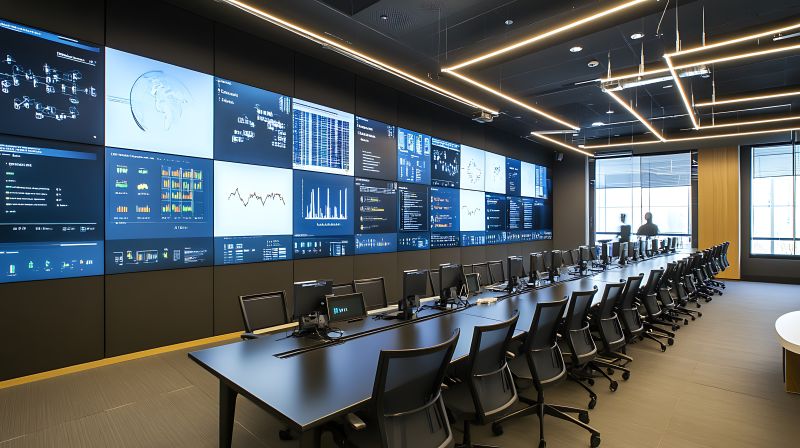Command-and-control environments are increasingly gaining integrators’ attention as client demand grows across verticals for mission-critical spaces capable of aggregating and presenting actionable information. These environments span military command centers, traffic control hubs, emergency operations hubs and even newer settings like hospital clinical command centers and school safety centers.
This article, which summarizes CI+SSI‘s in-depth Command-and-Control Deep Dive report, explores key highlights from that research. This includes insights into the category’s growth, its future potential, its technological underpinnings and whether command and control offers opportunities for all integrators or only for those with specific expertise.
Understanding Market Growth
Mike Sullivan-Trainor, senior industry analyst at AVIXA, highlights command and control’s solid growth rate relative to other segments of the pro AV industry. “The [compound annual growth rate, or CAGR] for command and control from 2025 to 2030, according to IOTA, is a strong 3.5% globally,” he explains, noting that this is slightly behind the general pro AV CAGR of 3.9% over the same period. This growth is driven by upgrade cycles in video displays, the proliferation of cloud-based services, and innovations in data management and artificial intelligence.
However, Sullivan-Trainor also notes challenges due to the sector’s maturity and sensitive applications. “Most of these solutions are mature from a technology and operational perspective,” he says. “They are also playing a critical role in use cases that are extremely sensitive to change.”
Developing markets show the greatest potential for growth as their strengthening economies demand new facilities and infrastructure.
Central Role of Data
Data is at the core of command-and-control environments, with experts pointing to its growing importance across various applications. Matt Boyer, vice president of mission-critical technology at CTI, asserts, “Data is the new oxygen. Organizations can’t afford to slow down decision-making.” He emphasizes that well-integrated systems can help manage traffic congestion or optimize patient care in real time.
Brad Righi, president of Constant Technologies, Inc., notes that societal challenges, like increased crime, are also accelerating demand. He states, “Civil unrest, rising incidents of organized retail crime like smash-and-grab thefts and the heightened focus on protecting critical infrastructure have all contributed to a growing need for centralized, mission-critical operations.”
Expertise-Driven Solutions
High-functioning command-and-control spaces require specific technological solutions and operator-centric designs to ensure effectiveness. Robert Henze, vice president of command and control at Visual Sound, emphasizes critical considerations to ensure that downtime is virtually never necessary. As he explains, “You need 24/7 system reliability, which includes power and data redundancy, proper cooling for all equipment and well-designed graphic user interfaces for operators to control the system easily.”
Meanwhile, Jon Litt, executive board member of the Command+Control Alliance (C2A), highlights that designs must cater to user needs above all else. “Everything starts with the operator and works its way out from there,” he notes. This means using appropriately sized displays and ensuring ergonomic functionality to reduce cognitive load under high-pressure scenarios.
Key Takeaways for Integrators
What follows are essential considerations for integrators and stakeholders exploring command-and-control solutions:
- Operator-Centric Design:
- Displays should be appropriately sized and positioned for maximum usability.
- Height-adjustable furniture and supportive consoles can reduce physical strain.
- Highly Reliable Systems:
- Implement power and data redundancy for continuous operations.
- Ensure proper systems cooling and seamless failover mechanisms.
- Technology Choices:
- Direct-view LED (DVLED), LCD videowalls and rear-projection solutions must align with specific use cases and budgets.
- Secure KVM and IP-based solutions provide the flexibility to analyze data faster, offering immediate sharing capabilities.
- Consultative Approach:
- Early collaboration with clients boosts alignment on sightlines, workflows and environmental considerations.
- Managed Services:
- Proactive maintenance and tailored service level agreements (SLAs) improve reliability and client retention.
Challenges and Future Innovations
Command and control remains a specialized market, and that means integrators must cultivate experience and expertise. Righi underscores the steep learning curve for integrators new to the space. Indeed, as he states, “These are not just AV projects.” Rather, he adds, “They are the nerve centers of organizations like government agencies, global banks, power utilities and tech giants.”
Looking ahead, artificial intelligence is expected to have a significant effect on this category. Sullivan-Trainor predicts, “Intelligent systems will operate over an IP network, feeding data to models in the cloud.” Boyer envisions a shift from reactive hubs to predictive systems, saying, “AI will take massive datasets, spot patterns and offer proactive insights.”
AI also has the potential to assist operators directly. Litt shares, “[AI can detect] specific types of activity, a type of vehicle, or a specific person…then [alert] the control-room operators to the find for the necessary action.”
The command-and-control category presents a robust opportunity for both AV integrators and security integrators who have the technical expertise to deliver on mission-critical needs. Although not suited for everyone, those who master its intricacies may find themselves at the forefront of innovation, shaping the future of operational decision-making.
Get All the Details on Command and Control
To read our complete CI+SSI Command and Control Deep Dive report, check out the full download on our website.




